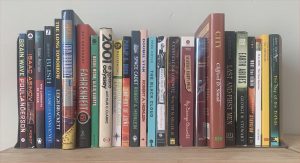Recent SF:
Beukes, Lauren. The Shining Girls. review.
Chambers, Becky. 2014/2015. The Long Way to a Small, Angry Planet. review
Doctorow, Cory. Homeland. review.
King, Stephen. Revival. review.
Kowal, Mary Robinette. 2018. The Calculating Stars. review.
Liu, Cixin. The Three-Body Problem. review.
McDevitt, Jack, & Mike Resnick. 2012. The Cassandra Project. review.
McGuire, Seanan. 2016. Every Heart a Doorway. review.
Morrow, James. The Madonna and the Starship. review.
Reynolds, Alastair. 2015. Slow Bullets. review.
Robinson, Kim Stanley. 2015. Aurora. review, follow-up
Steele, Allen. 2016. Arkwright. review.
Weir, Andy. The Martian. review.
Wilson, Robert Charles. 2015. The Affinities. review.
19th-20th century SF:
-
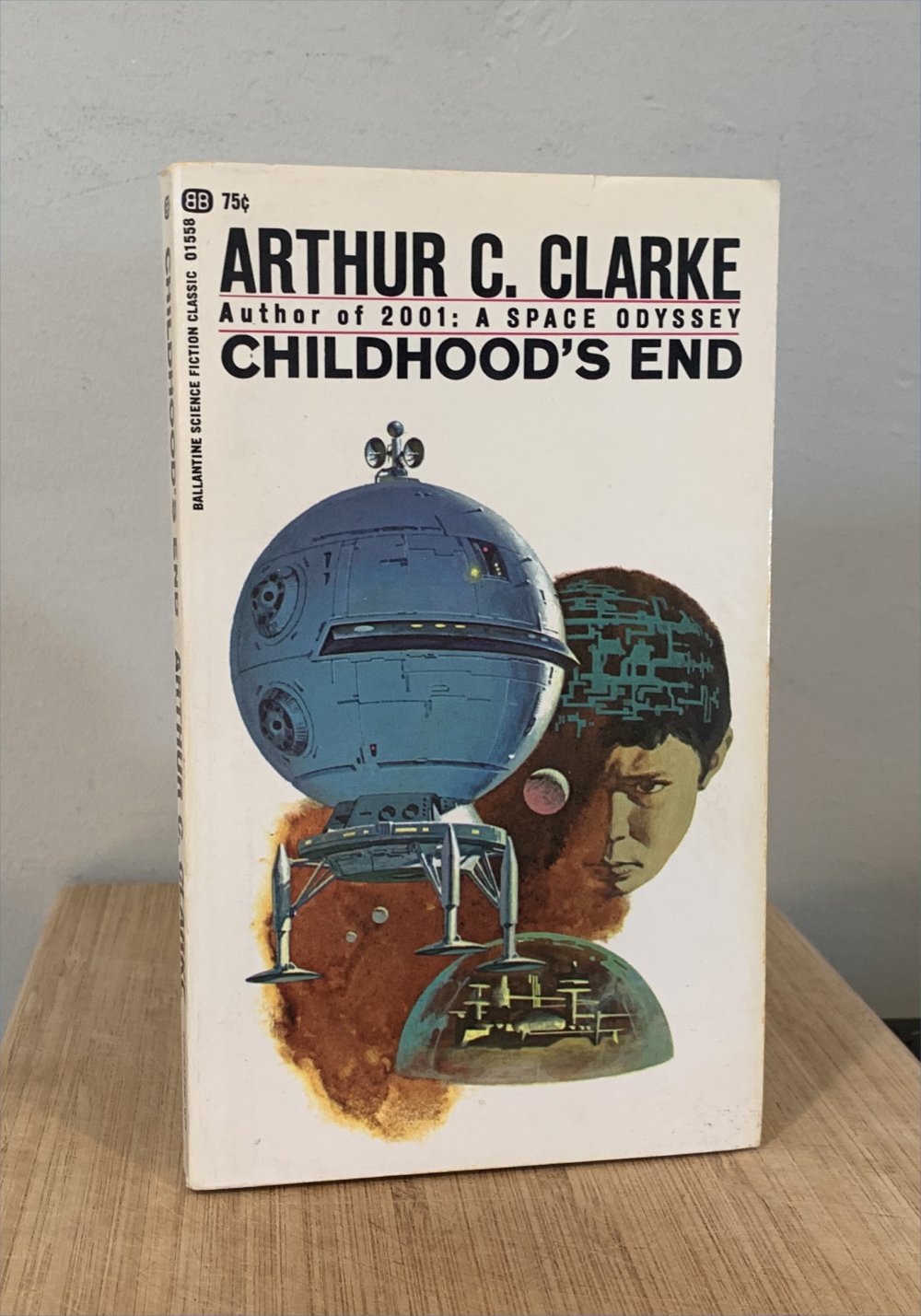 Clarke, Arthur C. Childhood’s End (1953) *****
Clarke, Arthur C. Childhood’s End (1953) *****
Vast spaceships appear over all Earth’s major cities, occupied by “Overlords” who refuse to reveal themselves. Their mere presence affects Earth’s culture in many ways. As decades pass, it becomes clear the Overlords’ concern is for certain of Earth’s children, as harbingers of a new phase of human existence. The book is credulous about paranormal powers in a way typical for its era, yet its powerful finale anticipates that of 2001. (part 1: discussion; part 2: themes; part 3: passages)
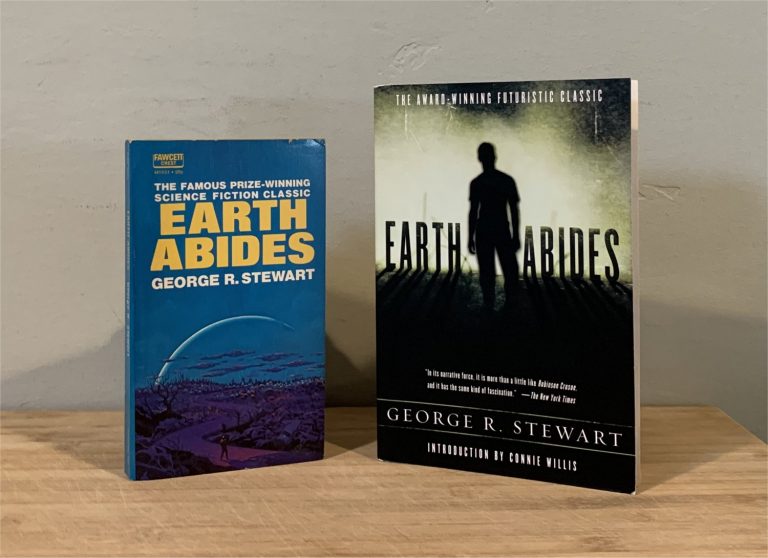 Stewart, George R. Earth Abides (1949) *****
Stewart, George R. Earth Abides (1949) *****
One of the best science fiction novels of all time, published before the “genre” of science fiction had taken hold, in the late 1940s. It’s about the aftermath of a worldwide plague that kills off virtually of humanity, and follows one survivor as he emerges from the mountains to his home in a deserted Berkeley CA. And it’s about him trying to rebuild a life, and deciding, with a few other survivors, what kind of world can possibly be rebuilt. Perhaps not very much; the survivors learn to accept that “Things are as they are, and I am part of them.” And even without humans, the Earth will survive. A profound, moving, beautiful book.
(detailed review; review at Black Gate)
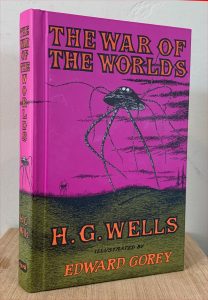 Wells, H. G. The War of the Worlds. 1897. *****
Wells, H. G. The War of the Worlds. 1897. *****
Intelligent aliens from Mars land on Earth, as “falling stars,” near London, and proceed to ravage the landscape as people flee or are killed. One of the most famous of all science fiction novels, and the template for countless alien invasion stories that followed. The well-known films based on the book follow the story very broadly, but change the setting and many details — e.g. in the book, the Martian ships walk around on tripods, and the Martians’ motives turn out to be to harvest humans for sustenance. The ending though is always the same. Wells evokes not just the terror of humans confronted with alien menaces, but the cosmic perspective of humanity’s future in space, and the biological protocols of natural selection in the defeat of the Martians. Contemporary readers might be put off by the extreme detail of locations in and around London, but Wells wrote the story for a magazine read by Londoners.
(notes and quotes)
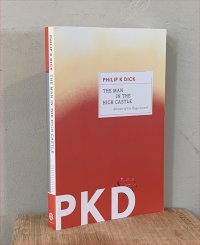 Dick, Philip K. The Man in the High Castle. 1962. *****
Dick, Philip K. The Man in the High Castle. 1962. *****
This is a novel set in an “alternate history” in which Japan and Germany have won World War II and taken over the United States between them. The story, set in the book’s ‘present,’ follows a San Francisco dealer in historical artifacts; a metal worker at a factory that manufactures fake artifacts; his ex-wife on a search for the author of a popular novel, The Grasshopper Lies Heavy, in which Japan and Germany *lost* the war; and an elaborate espionage plot by the Germans against Japan. One of PKD’s best (the quality of his books varied widely), it’s character- and culture-driven, fascinating in its historical speculative, introspective and philosophical, with one character using the I Ching to make everyday decisions, just as the author used it to write the book. Life is a series of random events, the book suggests, that humans manage to make sense of anyway. (summary)
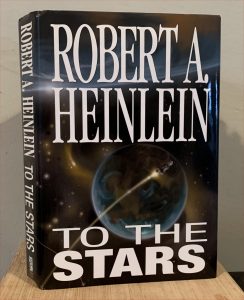 Heinlein, Robert A. Starman Jones. 1953. ***
Heinlein, Robert A. Starman Jones. 1953. ***
This is the 7th of 14 “young adult” novels that Heinlein wrote from the late 1940s to the early ’60, and perhaps my favorite of them. (They are all solid science fiction novels that are better, still, than almost all SF movies and TV shows.) In a future of expanding FTL travel, teenager Max runs away from his stepmother and her new husband (who threatens to sell Max’s books!). He finds a job on a starship, first as a low-level “spaceman,” tending passengers’ pets; then as a “chartsman”; until his eidetic memory of astrogation manuals, and eventually a series of accidents and tragedies, obliges him to take over captaincy of the ship itself, as “starman”. It’s a story of coincidences and handy talents, but it’s irresistible. Throughout are Heinlein’s familiar observations about culture, morals, professional secrets, and so on; and here, even about the shame of stealing library books. Includes the memorable line about what to do about overcooked eggs ordered in a diner. (summary)
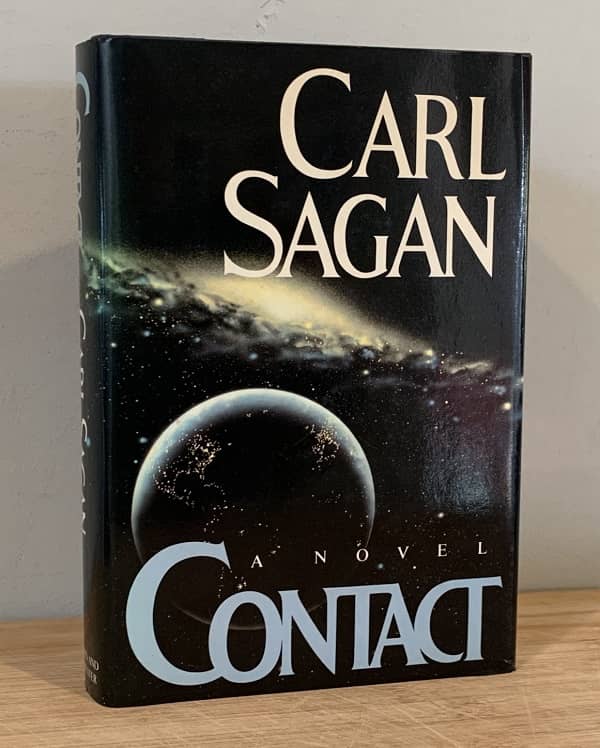 Sagan, Carl. Contact. 1985. ****
Sagan, Carl. Contact. 1985. ****
Sagan’s one novel, published five years after his book and TV series Cosmos, is like James Gunn’s novel below about SETI, and what happens when a signal is finally detected. SETI scientist Ellie Arroway, after years of searching, detects a signal from Vega that, once decoded, gives instructions for building a Machine. To do what? Travel to Vega? After a first Machine is destroyed by saboteurs, Ellie and four others become passengers on a second Machine, which takes them through wormholes to contact extraterrestrials who take the forms of people they love, and provide Ellie with a crucial clue about the nature of the universe. This is a serious novel about the scientific quest and the profound impact contact with intelligent extraterrestrials would have on the human race. It’s full of fascinating speculative asides, and its core speculative premise is profound in the best sense-of-wonder way. If it’s a tad more clinical than dramatic, it’s also deeper and subtler than Gunn’s novel, or the (albeit mostly admirable) film version. (Review at Black Gate, with some discussion of the 1997 movie version)
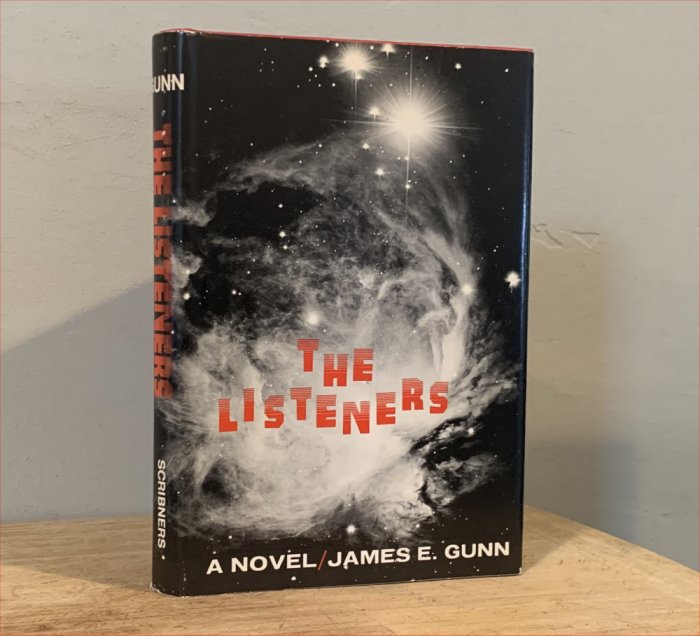 Gunn James. The Listeners. 1972. ***
Gunn James. The Listeners. 1972. ***
After 50 years scientists at the Arecibo radio telescope in Puerto Rico, engaged in SETI, the Search for Extra-Terrestrial Intelligence, finally detect a signal, a sequence of ones and zeroes with a length equaling the product of two primes. When laid out as a grid, it forms a diagram of an alien, apparently, pointing in various directions. The scientists deal with politicians, and religious leaders, with differing opinions about what the signal means, and whether humanity should respond. A sober, introspective book, as much about the motivations of scientists dedicated to a life of work with no guarantee of success, as about the philosophical debate about the wisdom of contact with alien intelligences. (Review at Black Gate, with warnings about the 2017 Reputation edition)
 Le Guin, Ursula K. The Dispossessed. 1974. *****
Le Guin, Ursula K. The Dispossessed. 1974. *****
A physicist, Shevek, from the barren, anarchist colony planet Anarres, travels to its home planet Urras, with its capitalist, patriarchal society. The Urrasians court him for a theory he is developing that could enable faster-than-light travel, or communication via an “ansible.” The narrative alternates Shevek’s experiences on Urras, as he becomes involved in a revolution, with his childhood and young adulthood on Anarres, as he struggles to learn Urrasian science and develop his own theory of transilience while being obliged to perform manual labor. The novel is impression for its contrast of political systems and philosophies (with feminist and Taoist themes notable), and for the plausible variant physics that enables a different way of looking at the world. It’s leisurely, solemn, often profound. (Summary; Wikipedia entry)
Others. BG = review posted at Black Gate.
Anderson, Poul. Brain Wave. review at Black Gate
Asimov, Isaac, 1972. The Early Asimov review
Asimov, Isaac, 1950. I, Robot review
Asimov, 1951. Foundation. review.
Asimov. 1952. The Currents of Space review
Asimov. xxxx. The Stars, Like Dust review
Asimov, 1950. Pebble in the Sky review; BG.
Asimov, 1952-1958. Six Lucky Star novels. review
Asimov. The End of Eternity. review at Black Gate.
Asimov. Fantastic Voyage. review at Black Gate.
Asimov, 1983. The Winds of Change. review.
Blish, James. A Case of Conscience. review at Black Gate.
Brackett, Leigh. The Long Tomorrow. review at Black Gate.
Bradbury, Ray. 1950. The Martian Chronicles. review.
Bradbury. 1955. The October Country. review.
Bradbury. 1957. Dandelion Wine. review.
Bradbury. 2006. Farewell Summer. review.
Budrys, Algis. Rogue Moon. review at Black Gate.
Clarke, Arthur C. 1973. Rendezvous with Rama review
Clarke, 1957. The Deep Range. review, BG
Clarke. Prelude to Space. BG
Clarke. A Fall of Moondust. BG
Clarke. Omnibuses, et al. BG
Clement, Hal, 1950. Needle review, BG
Dick, Philip K. Eye in the Sky, Solar Lottery, Time Out of Joint. BG
Golding, William. 1954. Lord of the Flies. review.
Heinlein, 1939/2003. For Us, the Living. review, BG
Heinlein, xxxx. Double Star review.
Heinlein, Robert A. 1941/1949. Sixth Column review, BG
Heinlein, xxxx. Between Planets. review.
Heinlein, 1948. Space Cadet. review.
Hoyle, Fred. The Black Cloud. BG
Keyes, Daniel, 1966. Flowers for Algernon. review.
Matheson, Richard. The Shrinking Man. BG
Miller, Walter M. A Canticle for Leibowitz review, BG.
Oliver, Chad, 1957. The Winds of Time. review, BG
Pohl, Frederik. 1972. The Gold at the Starbow’s End. review.
Pohl, 1977. Gateway. review.
Russell, Eric Frank. 1939/1948. Sinister Barrier. review, BG
Sheckley, Robert. 1966. Mindswap. review.
Silverberg, Robert, 1955. Revolt on Alpha C review
Silverberg. Collision Course. BG
Silverberg, xxxx. The Thirteenth Immortal. review.
Silverberg, 1969. Up the Line. BG.
Silverberg, 1972. Dying Inside. review.
Simak, Clifford D. 1952. City. review, BG
Wells, H. G. 1895. The Time Machine. review.
Wyndham, John. The Kraken Wakes/Out of the Deeps. BG.

